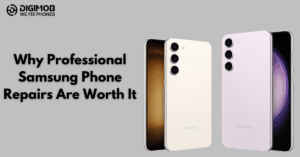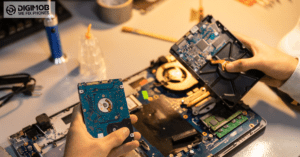Connecting your MacBook to an external display is one of the easiest ways to boost your productivity—whether you’re editing photos, coding, or just extending your screen real estate. But what happens when your MacBook refuses to recognize your monitor or projector? It’s frustrating, especially when everything seems plugged in correctly.
If your MacBook can’t detect an external display, don’t worry—this issue is more common than you think, and it often has a simple fix. In this blog, we’ll cover 10 quick ways to resolve the issue and help you get your display working smoothly again.
Why MacBooks Fail to Detect External Displays
Before we jump into the fixes, let’s understand the possible reasons your MacBook Repair might not recognize an external monitor:
- Loose or faulty cables
- Software glitches
- Outdated macOS
- Incompatible adapters
- Display settings misconfiguration
- Hardware issues with the MacBook or display
Sometimes, the root of the problem is as simple as a dirty port or as complex as a logic board failure. That’s why it’s important to go through a step-by-step troubleshooting process.
1. Check the Cable and Adapter Connections
Start with the basics. Ensure your HDMI, USB-C, Thunderbolt, or DisplayPort cables are properly plugged in at both ends. If you’re using an adapter (e.g., USB-C to HDMI), confirm it’s compatible with your MacBook model and the external monitor.
Quick Tip:
Try using the same cable and adapter on another MacBook or display to rule out faults.
2. Restart Your MacBook and Display
A simple restart can often resolve unresponsive hardware or software glitches. Power off both your MacBook and the external monitor, wait 30 seconds, then turn them on again. This clears temporary system bugs and resets the connection.
3. Detect Displays Manually
Sometimes macOS doesn’t automatically detect a display. Here’s how to force it:
- Go to System Settings (or System Preferences on older macOS versions)
- Navigate to Displays
- Hold the Option key, and the “Detect Displays” button will appear—click it
This can help your MacBook recognize the connected screen if it didn’t detect it initially.
4. Update macOS and Firmware
Running outdated software can cause compatibility issues. Make sure your MacBook is updated to the latest version of macOS.
- Go to System Settings > General > Software Update
- Install any available updates
New updates often include driver patches that improve connectivity with external monitors.
5. Try a Different Display or Port
If you suspect a hardware problem, test with another external monitor. Similarly, use a different port on your MacBook (if available) or a different input port on your monitor. This helps identify whether the issue lies with the MacBook, the monitor, or the cable.
6. Reset NVRAM/PRAM
Your MacBook stores certain display settings in NVRAM/PRAM. Resetting it can help solve detection problems.
How to reset:
- Shut down your MacBook
- Turn it on and immediately press and hold Option + Command + P + R
- Keep holding for about 20 seconds, then release
This clears old configurations and may allow your MacBook to re-establish a clean connection with the display.
7. Reset the System Management Controller (SMC)
SMC controls power and display functions on MacBooks. Resetting it can resolve display recognition issues, especially for Intel-based models.
For MacBooks with T2 chips:
- Shut down your MacBook
- Press and hold Control + Option (Alt) + Shift (right side) for 7 seconds
- Keep holding and press the Power button for another 7 seconds
- Release all keys, wait a few seconds, then turn your MacBook back on
For M1 or M2 MacBooks, SMC resets automatically upon restart.
8. Change Display Resolution Settings
Sometimes your MacBook may detect the display, but not display anything due to an incompatible resolution.
- Go to System Settings > Displays
- Select Scaled
- Try different resolutions until your external display responds
If you’re using a 4K monitor, make sure your MacBook supports it.
9. Use Safe Mode
Booting into Safe Mode loads only essential system extensions. This can help you identify if a third-party software or extension is interfering with external display detection.
How to enter Safe Mode:
- Intel Mac: Restart and hold Shift until the login screen appears
- M1/M2 Mac: Shut down > press and hold the power button > choose Safe Mode
Once in Safe Mode, check if the external display works. If it does, some software may be interfering in normal mode.
10. Seek Professional MacBook Repair Services
If none of the above solutions work, the problem could be deeper—like a faulty GPU, logic board issue, or damaged port. In such cases, it’s best not to try DIY repairs. This is where professional MacBook repair services come in.
Trained technicians can run diagnostics to detect hardware faults and carry out repairs safely. This is especially important if you’re dealing with liquid damage, display connector issues, or internal hardware failure.
When Should You Worry?
Here are a few signs it’s time to take your MacBook to a professional:
- Multiple external monitors fail to connect
- Ports feel loose or damaged
- MacBook heats up excessively when connected to a monitor
- The issue persists across different cables and adapters
- Display flickers or shows distorted output intermittently
These symptoms might indicate internal hardware problems that need expert attention.
Final Thoughts
When your MacBook can’t detect an external display, it doesn’t always mean a serious problem. Often, a few smart troubleshooting steps can fix it in minutes. However, if the issue persists after trying all the fixes mentioned above, don’t delay in seeking professional help.
For reliable, fast, and affordable MacBook repair services, trust the experts who understand your device inside and out.
Digimob Phone Repair offers professional diagnosis and repair for all MacBook display issues. From port replacements to logic board repairs, we’re here to help you get back on track.



